Boning knives, with their durability and high functionality, are essential for every kitchen, especially for those whose food preparation revolves around poultry, fish, or meat. These might not always be present in your traditional kitchen, but the uses are never-ending. Finding the best boning knife can be daunting with a wide range of options available. Read on to get a clear grasp of the usage of the knife, the different types, and more!
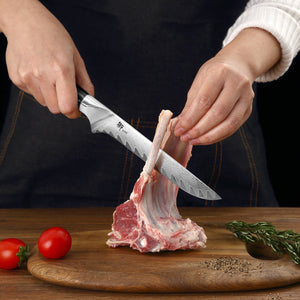
What Is a Boning Knife?
To get the most out of the best boning knife, it is essential to understand its purpose. Used in the kitchen, a boning knife comes with a sharp edge and a narrow and thin blade. More than often, a boning knife, as the name indicates, is used during food preparation to get rid of the bones and ligaments from fish, poultry, and meat.
The length of a boning knife differs from one type to the next, but it is usually around 12 cm to 17 long. The narrow blade of the best boning knife is what makes it stand apart from the rest in the kitchen. The thin and narrow blade made it perfect for the precision requiring the job of deboning. A sharp and precise blade can make deeper holes and cuts. Moreover, the flexibility of the boning knife is a feature that comes in aid while dealing with fish and poultry.
Types of Boning Knives
There is a wide range of types available in the best boning knife. The one you decide to pick for your use should be chosen based on your mind. It is also advised to have more than one type of boning knife on hand to achieve professional deboning.

Following are some of the most common types of boning knives.
1. Wide Boning Knives
Wide boning knives, as the name indicates, are made with a wider blade and are preferred for cutting pork and chicken. The blade is stiffer and allows ease in cutting through the texture of both.
2. Narrow Boning Knives
Narrow boning knives are the narrowest blade of them all and are highly preferred while dealing with ribs. The narrow blade of the best boning knife of this sort would easily slice and chop through cartilage and bone, offering a high level of precision and ease. Usually made from steel, these knives are often curated with honed edges.
3. Stiff Boning Knives
Stiff boning knives are perfect for sturdy pieces of meat, including beef or pork. If you intend on preparing raw meat that is much more thick and tough, you might consider using a stiffer boning knife. T-bone chops and beef, for example, have far too much stiffness against a bendable blade, and hence a stiffer one would be used for quick and clean cuts.
4. Flexible Boning Knives
Flexible boning knives can bend, allowing you to deal with portions of the flesh that would otherwise be impossible to reach. At times, bones with curvature or rounding ends might feel rather challenging to tackle. These strange shapes may cling to valuable sliced pieces, which have a lot of taste in them. This is where a flexible boning knife comes into play.
Fillet & narrower slices of meat that are more complicated to bone can be readily penetrated using a flexible boning knife. These are quite similar to filet knives.
5. Curved Boning Knives
On your quest to locate the best boning knife, you will come across various curved boning knives. These, as the name indicates, come with a curved edge that offers you ease in angling while chopping and cutting around the bone. The curved boning knife is relatively smaller than your flexible ones and is best for deboning and removing skin from pish and poultry. These are also best used when dealing with tender meats and delicate poultry.
Boning Knife Uses
Boning knives offer a wide range of uses, from cutting the cartilage away to removing skin from different types of meat and even eliminating the minute ligaments that can be present such as silverside. Using the best boning knife in the kitchen is essential as it offers the precision that a regular knife, no matter how scrap it is, would provide. Down below is complete at the different uses of the best boning knife.
· Removal of Skin
The best boning knife can help with the intricate job of removing skin from the meat, including silverside. Since these knives come with a narrow and flexible blade, they remove the skin of poultry chicken and even get rid of sinew from red meat.
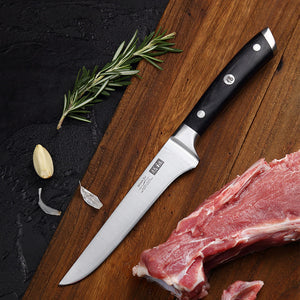
· Removal of Bones
The most common use of a boning knife is to remove bones, be it chicken, meat, or fish. The best way to remove the bone is to identify its location and start making a tiny incision. Once done, the incision can help remove a wider piece of the meat, offering access to the bone in clarity.
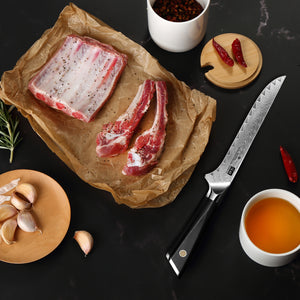
How To Choose the Best Boning Knife?
In order to get your hands on the best boning knife, you need to keep a few aspects in consideration before making the purchase. Here is what you need to look for in the best boning knife.
· Blade
First and foremost is the blade of the knife. There are two choices available; you can either opt for a stiff blade or a flexible one. The answer to this depends on how you wish to utilize the knife. A stiff blade is usually preferred since it gets the work done of cleanly removing the bone from the meat.
There is also the option of a semi-flexible blade which would work great if you are looking for a knife that would work as both a filet knife and boning knife. The design of the blade is also another factor, and you can pick from narrow, wide, stiff, flexible, and curved ones.
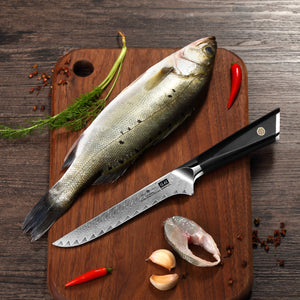
· Size and Shape
Next up is the shape and size of the knife. This is a crucial factor as it affects the handling and your comfort. The best part is that boning knives come in a variety of shapes and sizes and hence can accommodate your different chopping needs.
A blade of six inches is perfect for baseline cutting with a steep shape and a pointed edge. Size mainly depends on the amount and the size of the meat you're dealing with. For everyday use, a six-inch knife would do wonders, but you can go up a size for larger sizes.
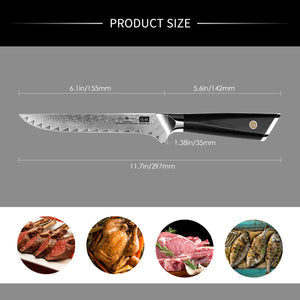
· Finger Guard
Safety is of utmost importance when dealing with knives, be it for beginners or professionals. Fortunately, boning knives come with a finger guard located near the blade and the handle. It offers a firmer grasp which is often needed while cutting through slimy or wet meat. The placement of the finger guard is so that professionals can ignore it if need be while beginners can make the most out of it.

· Built
The build of the knife is yet another factor to consider. You can look at the material, the tang, and the handle in the built. It is said that boning knives with a wooden handle are the epitome of elegance, but these tend to get warped after too much exposure to water.
On the other hand, metal ones are durable, but they can be lesser secure grasp-wise. The best material advised is polypropylene since the plastic requires the least maintenance and can live a long life.

FAQs
1. What's the difference between a boning knife and a filet knife?
The major difference between a boning knife and a filet knife is the weight and the material. The best boning knife out there will be relatively heavier and rigid. On the other hand, filet knives are lighter and flexible.
2. Which is the suitable type of boning knife for removing bones in small spaces?
A curved boning knife is the most suitable type for cutting skin and deboning in small spaces for fish and poultry.
3. Do you need a boning knife?
Yes, a boning knife is a must for those dealing with poultry. Instead of depending on knives with specialized specialties for cutting meat bone, slicing bread, or other smaller precision jobs, boning knives are preferred.
4. Are boning knives flexible?
Yes, boning knives are flexible and thin blades designed to debone and cut straight through tissue and ligaments.
5. How can I sharpen the boning knife?
Since the blade is thinner, it is advised to angle the knife on a whetstone and sharpen one side at a time by lightly pressing. Once done, rinse your knife, and you're done.
6. How to clean the boning knife properly?
Always clean your boning knife quickly after each use with warm, soapy water and a clean cloth or gently brush if required to remove dirt, then dry with a towel.
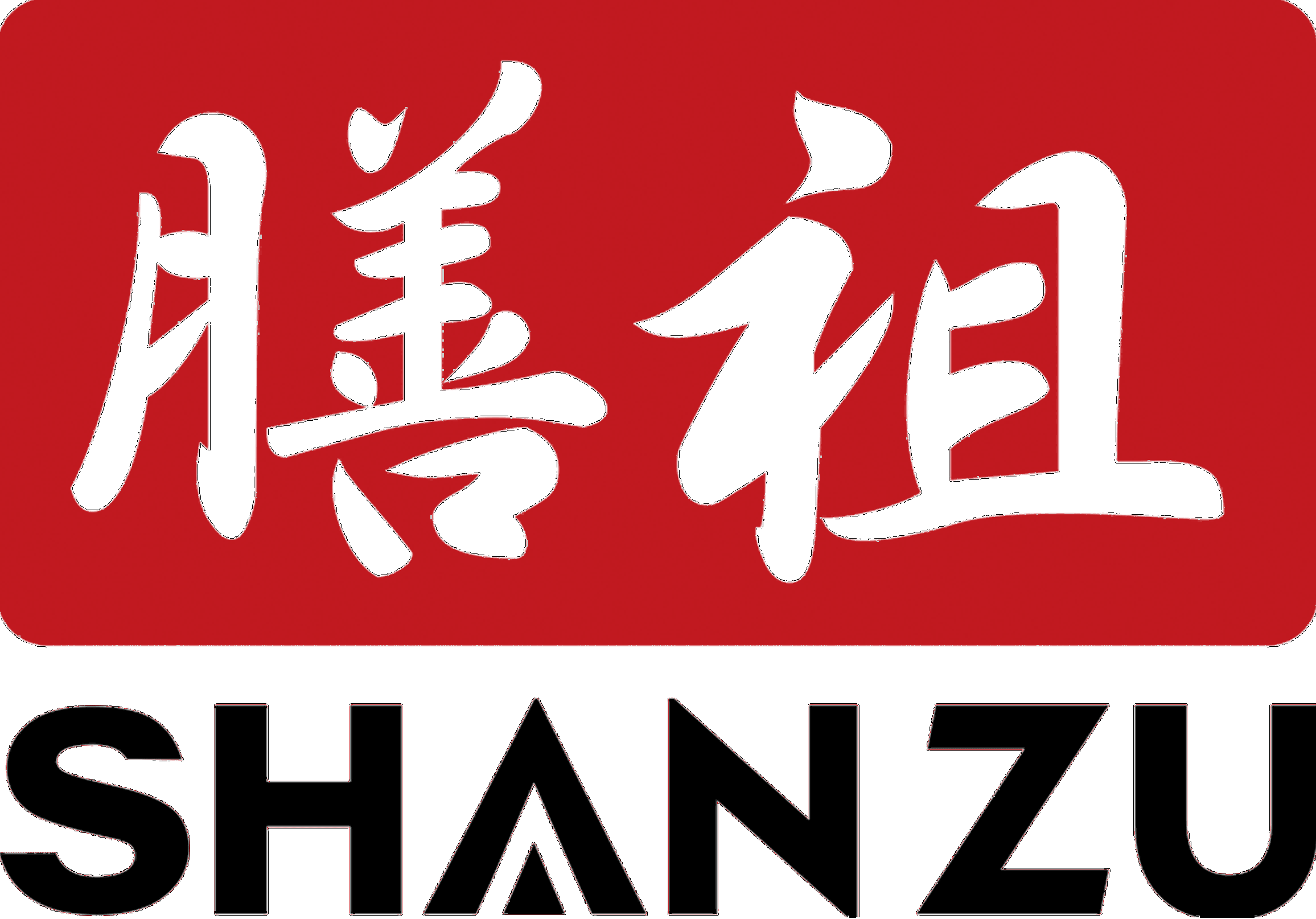


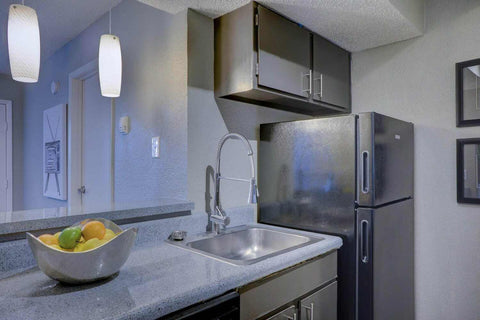

Commentaires (0)
Il n'y a pas de commentaires pour cet article. Soyez le premier à laisser un message !